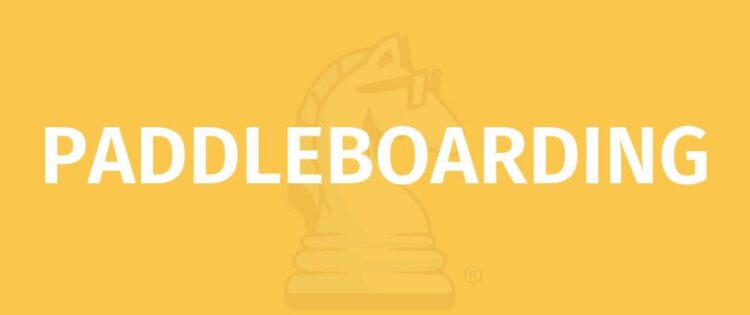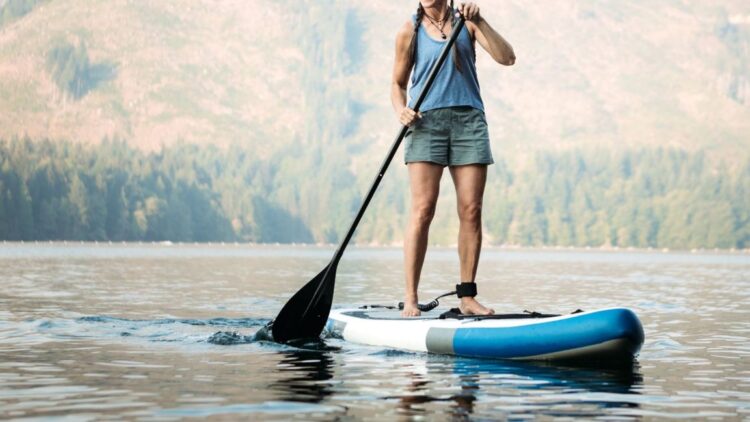
OBJECTIVE OF PADDLEBOARDING: Cross the finish line before all other competitors.
NUMBER OF PLAYERS: 3+ players per race
MATERIALS: A paddle board, paddle, leash, floatation device, rescue tools
TYPE OF GAME: Sport
AUDIENCE: 5+
OVERVIEW OF PADDLEBOARDING

You may think that paddleboarding is simply a water activity, but paddleboarding is now a competitive sport with large competitions around the world.
Paddleboarding is a water sport that sees individuals race across open water on flat “paddleboards” that closely resemble surfboards. This sport is often called “stand-up paddleboarding” (SUP) because most competitive events require the competitors to paddle from a standing position.
Paddleboarding’s roots can be traced back thousands of years to when people used paddles and sticks to maneuver rafts down waterways as a simple form of transportation. However, the modern version of this activity can be credited to Hawaiian John Ah Choy, who helped develop the sport in the 1940s.
As an aging avid surfer, Choy found himself unable to constantly get up and down on his board. So instead of giving up on surfing, he decided to stand on his board and paddle himself around the water using a canoe paddle. His sons quickly followed in his footsteps, regularly teaching tourists visiting the islands how to do the same.
In the 1990s, American Laird Hamilton turned this pastime activity into a thriving competitive sport and began organizing races. In 2004, stand-up paddleboarding was featured in the Buffalo Big Board Classic, an annual surfing event held in Hawaii. From this point on, SUP has blossomed in popularity, specifically among recreational participants.
In 2020, the Court of Arbitration for Sport determined that official stand-up paddleboarding competitions could be organized by both the International Surfing Association (ISA) and International Canoe Federation (ICF). In doing so, the court also ruled that the ISA would be in charge of any Olympic competitions. Since then, the ISA has regularly pushed for SUP to be featured in an upcoming Summer Olympic Games alongside the shortboard surfing event. Unfortunately, there has yet to be any success in this endeavor.
SETUP
EQUIPMENT
- Paddleboard: Paddleboards closely resemble surfboards and are designed to fully float on water. Unlike a surfboard, however, paddleboards are often thicker, wider, and more sturdy. Most competition paddleboards are comprised of wood, fiberglass, and a PVC veneer, although some competitions use an inflatable race board. Some even have a displacement hull meant to prioritize speed, and your ability to paddle faster, over stability, where a planing hull does the opposite.
- Paddle: Lightweight carbon fiber paddles are used to propel and steer the board across the water. These paddles should be about 8 to 15 inches taller than the user.
- Leash: A leash wraps around a paddler’s ankle or leg and attaches them to their board in case they fall off.
- Personal Flotation Device: Coast Guard-compliant lifejackets must be worn by all competitors to stay afloat in case of emergency.
- Rescue Tools: Depending on the event and location, paddlers may take flares, lights, whistles, or signaling mirrors to signify they are in distress on the water on race day.
EVENTS
There are three main paddleboard events:
- Sprint
- A short-distance race never exceeding 250 meters (273 yards) in length.
- Competitors often race in groups of eight.
- Long Distance
- Race distance can be as short as 3 miles or as long as 20 miles.
- A large field of competitors all begin at the starting line together in a mass group paddle start.
- Technical Course Race:
- Race distance ranges from 0.5 miles to 3 miles.
- All competitors begin the race course on the beach and start paddling from the shore.
- Similar to competitive sailing, paddlers traverse an open-water course and must steer around several large buoys that mark the course.
Check out this video which shows racers competing in a technical race:
GAMEPLAY

SCORING AND COMPETITION FORMAT
As with most racing sports, every paddleboard race is won by the paddler who crosses the finish line first.
However, events with a large number of competitors must be broken into various heats. To determine a winner, organizers may choose to hold a finals round with all the top finishers competing or decide the winner based on their finishing time.
RECREATIONAL PADDLEBOARDING
Although paddleboarding’s popularity as a competitive sport hasn’t reached its full potential yet, the same cannot be said for it as a recreational activity.
According to a 2013 report, paddleboarding was listed as the most popular outdoor activity among first-time participants. Just one year later, in 2014, it was found that 2.8 million Americans participated in various stand-up paddleboarding activities and local races. This was a significant number, as this was nearly a 30% increase in 2013’s participation numbers of 2 million Americans.
Recreationally, paddle boards are a popular alternative to canoes, other race boards, and kayaks. Part of this is because they can be incredibly easy to maneuver and allow a person many different ways of doing so. For example, a paddler can stand (also called a SUP race), sit, kneel, or even lie down on their stomach and use their hands to paddle. Furthermore, the flat structure of the paddleboard makes it very easy to get on and off, making it a great choice for those looking to swim while out adventuring or participating in their first race.
END OF GAME
SUP racing is won by the elite athletes who cross the finish line first or has the fastest finishing time.
- 30 GAMES TO PLAY OVER TEXT - April 22, 2024
- 20+ FREE PRINTABLE BABY SHOWER GAMES - April 16, 2024
- 20+ College Party Games for the Best Night Ever! - April 2, 2024